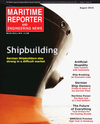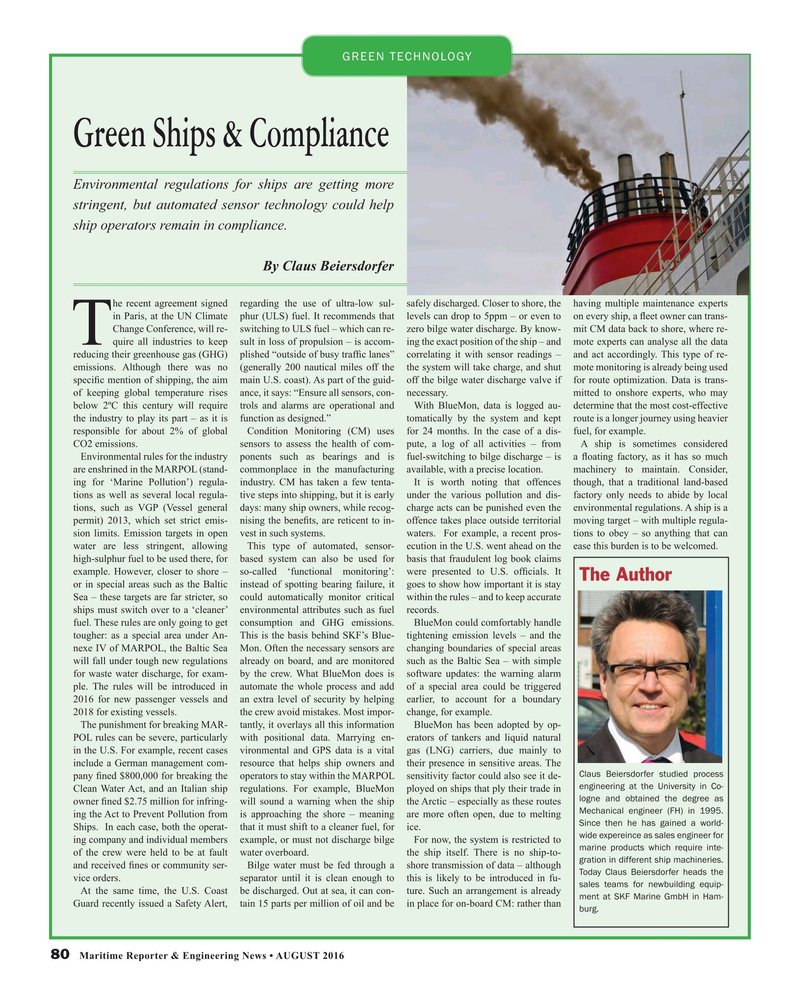
Page 80: of Maritime Reporter Magazine (August 2016)
The Shipyard Edition
Read this page in Pdf, Flash or Html5 edition of August 2016 Maritime Reporter Magazine
GREEN TECHNOLOGY
Green Ships & Compliance
Environmental regulations for ships are getting more stringent, but automated sensor technology could help ship operators remain in compliance.
By Claus Beiersdorfer he recent agreement signed regarding the use of ultra-low sul- safely discharged. Closer to shore, the having multiple maintenance experts in Paris, at the UN Climate phur (ULS) fuel. It recommends that levels can drop to 5ppm – or even to on every ship, a ? eet owner can trans-
Change Conference, will re- switching to ULS fuel – which can re- zero bilge water discharge. By know- mit CM data back to shore, where re-
Tquire all industries to keep sult in loss of propulsion – is accom- ing the exact position of the ship – and mote experts can analyse all the data reducing their greenhouse gas (GHG) plished “outside of busy traf? c lanes” correlating it with sensor readings – and act accordingly. This type of re- emissions. Although there was no (generally 200 nautical miles off the the system will take charge, and shut mote monitoring is already being used speci? c mention of shipping, the aim main U.S. coast). As part of the guid- off the bilge water discharge valve if for route optimization. Data is trans- of keeping global temperature rises ance, it says: “Ensure all sensors, con- necessary. mitted to onshore experts, who may below 2ºC this century will require trols and alarms are operational and With BlueMon, data is logged au- determine that the most cost-effective the industry to play its part – as it is function as designed.” tomatically by the system and kept route is a longer journey using heavier responsible for about 2% of global Condition Monitoring (CM) uses for 24 months. In the case of a dis- fuel, for example.
CO2 emissions. sensors to assess the health of com- pute, a log of all activities – from A ship is sometimes considered
Environmental rules for the industry ponents such as bearings and is fuel-switching to bilge discharge – is a ? oating factory, as it has so much are enshrined in the MARPOL (stand- commonplace in the manufacturing available, with a precise location. machinery to maintain. Consider, ing for ‘Marine Pollution’) regula- industry. CM has taken a few tenta- It is worth noting that offences though, that a traditional land-based tions as well as several local regula- tive steps into shipping, but it is early under the various pollution and dis- factory only needs to abide by local tions, such as VGP (Vessel general days: many ship owners, while recog- charge acts can be punished even the environmental regulations. A ship is a permit) 2013, which set strict emis- nising the bene? ts, are reticent to in- offence takes place outside territorial moving target – with multiple regula- sion limits. Emission targets in open vest in such systems. waters. For example, a recent pros- tions to obey – so anything that can water are less stringent, allowing This type of automated, sensor- ecution in the U.S. went ahead on the ease this burden is to be welcomed.
high-sulphur fuel to be used there, for based system can also be used for basis that fraudulent log book claims example. However, closer to shore – so-called ‘functional monitoring’: were presented to U.S. of? cials. It
The Author or in special areas such as the Baltic instead of spotting bearing failure, it goes to show how important it is stay
Sea – these targets are far stricter, so could automatically monitor critical within the rules – and to keep accurate ships must switch over to a ‘cleaner’ environmental attributes such as fuel records.
fuel. These rules are only going to get consumption and GHG emissions. BlueMon could comfortably handle tougher: as a special area under An- This is the basis behind SKF’s Blue- tightening emission levels – and the nexe IV of MARPOL, the Baltic Sea Mon. Often the necessary sensors are changing boundaries of special areas will fall under tough new regulations already on board, and are monitored such as the Baltic Sea – with simple for waste water discharge, for exam- by the crew. What BlueMon does is software updates: the warning alarm ple. The rules will be introduced in automate the whole process and add of a special area could be triggered 2016 for new passenger vessels and an extra level of security by helping earlier, to account for a boundary 2018 for existing vessels. the crew avoid mistakes. Most impor- change, for example.
The punishment for breaking MAR- tantly, it overlays all this information BlueMon has been adopted by op-
POL rules can be severe, particularly with positional data. Marrying en- erators of tankers and liquid natural in the U.S. For example, recent cases vironmental and GPS data is a vital gas (LNG) carriers, due mainly to include a German management com- resource that helps ship owners and their presence in sensitive areas. The
Claus Beiersdorfer studied process pany ? ned $800,000 for breaking the operators to stay within the MARPOL sensitivity factor could also see it de- engineering at the University in Co-
Clean Water Act, and an Italian ship regulations. For example, BlueMon ployed on ships that ply their trade in logne and obtained the degree as owner ? ned $2.75 million for infring- will sound a warning when the ship the Arctic – especially as these routes
Mechanical engineer (FH) in 1995. ing the Act to Prevent Pollution from is approaching the shore – meaning are more often open, due to melting
Since then he has gained a world-
Ships. In each case, both the operat- that it must shift to a cleaner fuel, for ice.
wide expereince as sales engineer for ing company and individual members example, or must not discharge bilge For now, the system is restricted to marine products which require inte- of the crew were held to be at fault water overboard. the ship itself. There is no ship-to- gration in different ship machineries. and received ? nes or community ser- Bilge water must be fed through a shore transmission of data – although
Today Claus Beiersdorfer heads the vice orders. separator until it is clean enough to this is likely to be introduced in fu- sales teams for newbuilding equip-
At the same time, the U.S. Coast be discharged. Out at sea, it can con- ture. Such an arrangement is already ment at SKF Marine GmbH in Ham-
Guard recently issued a Safety Alert, tain 15 parts per million of oil and be in place for on-board CM: rather than burg. 80 Maritime Reporter & Engineering News • AUGUST 2016
MR #8 (74-81).indd 80 8/3/2016 10:08:20 AM

 79
79

 81
81
